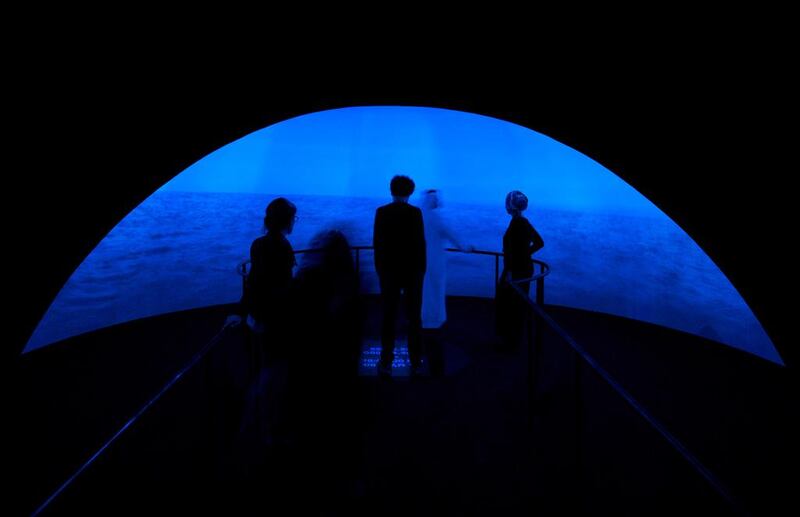In the heart of a city stretched across the water of a 40-kilometre-wide lagoon and linked only by canals and a network of bridges, it’s somehow fitting that the 2013 National Pavilion of the UAE at the Venice Biennale was an installation constructed to make the viewer feel as if they were stranded at sea, bobbing like a cork on a choppy ocean.
Mohammed Kazem’s Walking on Water, a two-minute looped video played through 15 projectors onto a custom-made dome, was the realisation of a project that the artist had imagined since 2005. Curated by Reem Fadda, who’s also the associate curator of Middle Eastern art for the Guggenheim Abu Dhabi, the installation was intended as a reflection of the UAE’s highly sophisticated art scene and was an attempt to show the world that our artists are “not sheltered, not compromised and they have been questioning themselves and their art for many years”, she says.
Exceeds expectations
Walking on Water was the nation’s third participation at the Venice Biennale. Since the beginning of June, it’s witnessed a daily flow of visitors. Publicly, the general consensus is that this is the strongest pavilion yet. Dr Lamees Hamdan, who has had the role of commissioner since 2009, when the country’s participation began, said it was “very successful” and that “everything was perfect”, exceeding the team’s expectations.
As well as acclaim for the artist and the growing importance of the UAE’s global art contribution, the past six months have also brought with them a number of firsts. This is the first time that the UAE has presented a single artist and the UAE is the first Gulf nation to be granted a long-term pavilion at the Biennale. The National Pavilion also produced Kazem’s first monograph publication, which documents the 20-year career of this prolific artist who – until he was pushed to the forefront with this event – was still somewhat in the shadows.
Bright prospects
The future, too, looks set to make artistic history for the UAE. It was confirmed yesterday that the Sheikha Salama bint Hamdan Al Nahyan Foundation, the former sponsors of the National Pavilion, will take over from Dr Hamdan in the role of commissioner, meaning that it will oversee the artistic programme from now on.
The UAE team also announced that it will be taking part for the first time in the Venice Architecture Biennale, which takes place during the alternate years to the art exhibition. Directed by Rem Koolhaas, the Architecture Biennale is scheduled to run from June until November next year. Michele Bambling has been appointed as curator for the UAE’s contribution.
Sheikha Mariam bint Mohammed Al Nahyan, the chair of the foundation, says that Bambling’s research on urban development in the UAE will be of great value and benefit to this exhibition.
“The UAE has always been in the centre of architecture academic debate and research, being one of the fastest-growing countries in the world,” she says. “Thus, our participation this year comes as a natural step for the country’s growing architectural and urban scene, and we are certain that our first exhibition will continue the successful legacy of the UAE’s role in La Biennale di Venezia.”
Taking charge
That legacy will be continued personally by a group of de facto Emirati art ambassadors who participated in the robust internship programme that ran the full course of the exhibition.
Described by Dr Hamdan as “an elite opportunity for creative Emiratis to take part in the Biennale as exhibition managers”, the six interns each spent one month in Venice manning the pavilion and interacting with visitors.
They were accompanied by six Italian interns from the Ca’ Foscari University in Venice, working hand-in-hand with them and enriching the cultural exchange.
“I am happy that the programme has proved once again that it is indeed an important part of the country’s international representation,” says Dr Hamdan.
Sara Al Haddad, one of the interns, says that she learnt a lot, both personally and professionally. “As an artist, I found it refreshing to be at the observer’s end and find out how visitors interact with the art,” she says. “It was also a wonderful experience to be given the opportunity to live in another country for a month. And to have the chance to represent your own country in one of the greatest international art biennales is something I will always be thankful for.”
• The 14th International Architecture Exhibition in La Biennale di Venezia is scheduled to open on June 7, 2014, and run until November 23, 2014. Dates have not yet been announced for the 2015 art biennale
[ aseaman@thenational.ae ]





